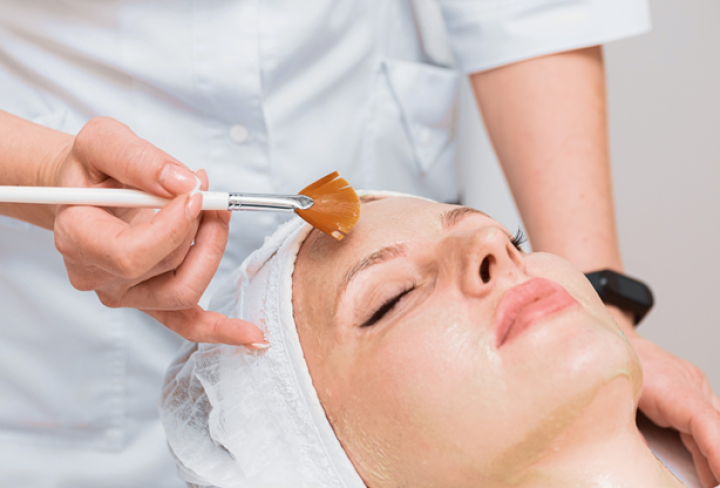A chemical peel is a treatment used on the face or body to diminish a wide range of skin conditions and improve the appearance of the skin.
It is a form of chemical exfoliation where the dead skin cells are destroyed, causing a layer of the skin to peel off.
Chemical peeling is used to diminish the signs of ageing on the face, hands, neck, and chest. Chemical peeling also treats certain skin conditions like acne and conditions that discolour the skin.
Conditions a Chemical Peel can Treat
A chemical peel can treat-
· Fine lines and wrinkles
· Acne scars
· Sunspots
· Large pores
· Pigmentation
· Melasma
Chemical peeling makes skin look healthy, bright, smooth, and radiant.
Why is Chemical Peeling done?
A chemical peel is a skin-resurfacing procedure categorized based on the intensity into three types which include-
- Superficial chemical peels affect the outer layer of the epidermis, suitable for minor, superficial imperfections, and general refreshment of complexion for a healthy look
- Medium-depth chemical peels are a bit more intense and used for deeper imperfections
- Deep chemical peels are very intense and used to treat severe dermatological conditions (only used for deeply rooted imperfections)
Your doctor will choose a chemical peel suitable for your skin and conditions.
How to prepare?
Your doctor will choose a chemical peel suitable for your skin and skin conditions.
Before a chemical peel, the doctor will-
Review your medical history: You must mention your current and past medical conditions, medications, or recent cosmetic procedures.
Perform a physical exam: The doctor will inspect your skin to determine the type of peel you need.
In some cases, you might also need to use some medications or applicants like-
- Antiviral medication to help prevent a viral infection
- Retinoid cream to help with healing
- Bleaching agent to reduce the risk of side effects
What to Expect?
A chemical peel is an outpatient procedure. You may not need painkillers for superficial chemical peels, but a sedative or painkiller may be used during a medium chemical peel. A sedative is used to numb the treatment area for a deep peel, or intravenous (IV) fluids may be given.
During a superficial chemical peel-
· You might feel a mild stinging on the application of a chemical solution is the skin
During a medium chemical peel-
· You might feel stinging or have a burning sensation for up to 20 minutes
· The doctor will apply cool compresses to soothe the treated skin
During a deep chemical peel-
- You may be given intravenous (IV) fluids, and your heart rate will be monitored
- Your skin will begin to turn white or grey
- The procedure might take about 90 minutes
Any chemical peel might make your skin red, tight, irritated, or swollen for some time.
Usually, it may take time for your skin to return to normal and see the results.
Things to Follow After a Chemical Peel
• Avoid picking, rubbing, or scratching your skin
• Avoid sun exposure: Too much exposure to the sun can cause permanent irregular pigmentation in treated areas.
• Avoid specific cosmetic skin and hair treatments: Avoid hair removal techniques, hair dying and hair-straightening treatments, facial masks, or facial scrubs.
• Do not shave the areas to be treated 24 hours before your peel.
• Use sun protection, cleansing, moisturizing and protective ointments as directed by the doctor.
• Use ice packs and over-the-counter pain-relieving medications to help reduce any discomfort.
• Treated skin might begin to form a crust and darken. It takes about 7-14 days to heal after a medium chemical peel.
Follow instructions as directed by the doctor.
Are Chemical Peels Safe?
Yes, if done by a certified, experienced medical professional.
However, there are certain risks which include-
- Scarring
- Chemical Burns
- Infection
- Allergic reactions to acids
- Blistering
- Inhalation of chemicals
Darkening or lightening of the skin colour
Chemical Peeling: Are you the right candidate?
Anyone might benefit from a light chemical peel as it diminishes minor imperfections and makes your skin healthy and look refreshing.
If you want to work on a certain imperfection, consult a specialised doctor to assess your skin and decide what type of chemical peel suits you.
Pros and Cons of Chemical Peeling: Are they worth it?
Pros:
Chemical peeling reduces wrinkles, Fine lines, Age spots, Acne spots, Pigmentation
Cons:
Chemical peeling does not work for severe wrinkles and may cause scarring, burns, darkening of the skin, infections, and allergic reactions
Dos and Don’ts
Do’s
Take advice from a certified skin care professional to help find the chemical peel that suits your skin
Inform your skin care professional about all the medications you are using
Inform your skin care professional if you have any allergies
Follow a proper daily protection regimen as advised by your doctor for the best results
Inform your skin care professional if you have any history of skin conditions
Discontinue use of products containing retinol or glycolic acid
Don’ts
· Do not try to do a chemical peel yourself
· Do not expose your skin to the sun, harsh environments, or pollutants
· Do not wax or use any hair removal chemicals for a week before and after treatment
· Do not pick your skin that may be peeling
· Do not overdo it – Your skin is a protective barrier!
Expert Guide for Chemical Peeling
· Your skin care professional will advise you about the type of chemical peel that suits you
· Your doctor will recommend the number of sittings required based on your skin condition
· Usually, about 3-7 sittings are given at an interval of 2-3weeks


